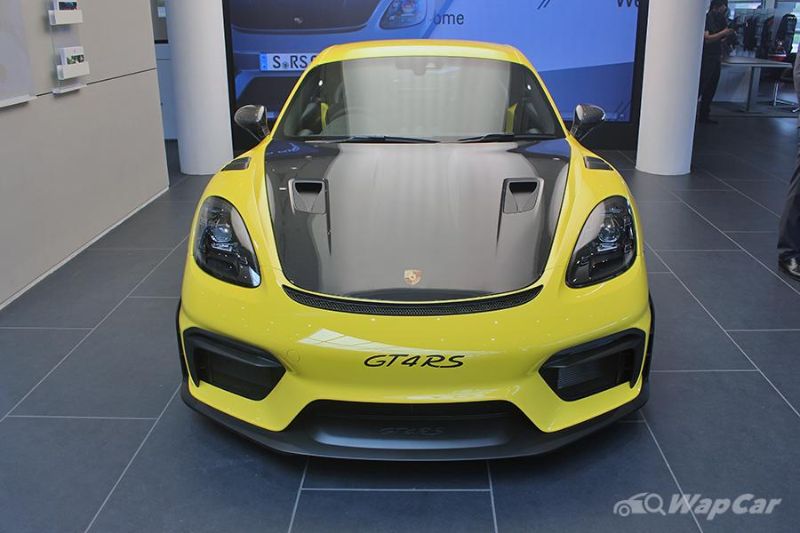
The RennSport name which is German for racing sport is often reserved for the iconic Porsche 911 as its most track-focused and driver-centric version. For the first time ever though, the RS badge is placed on its entry-level sibling, the Porsche 718 Cayman GT4 RS and it’s here in Malaysia.

Launched at the newly opened Porsche Centre Johor Bahru (PCJB) in Danga Bay, the 718 Cayman GT4 RS (we’ll just call it the GT4 RS from here on) is priced from RM 1,550,000.

Slotting above the previous range-topper in the 718 Cayman range, the GT4, the GT4 RS is powered by the same 4.0-litre naturally-aspirated flat-six that is found in the 911 GT3. With a redline of 9,000 rpm, the unit produces 500 PS and 450 Nm which is 3 PS and 20 Nm less than the 911 GT3.
Also read: Review: Porsche 911 GT3 – Bought a turbocharged supercar? Such a shame

The figures are lower than its rear-engine big brother due to the longer exhaust pipes that are needed for the mill to fit into a mid-engine sports car. This results in losses due to back pressure. Still, the GT4 RS produces 80 PS and 20-30 Nm more than the GT4.
Also read: Review: Porsche 718 Cayman GT4, a perfectly irrational middle finger to turbo+DCT sports cars

Top speed for this hardcore 718 Cayman is 315 km/h while it takes just 3.4 seconds to reach 100 km/h from rest. In comparison, the “regular” GT4 maxes out at 302 km/h while 0-100 km/h takes 3.9 seconds.
Also read: Porsche 718 Cayman GT4 and 718 Spyder launched in Malaysia, 4.0L NA, 6-speed manual only!

As pure as having an NA engine in an age of turbo and electrification in 2022, the only transmission available for the GT4 RS is a 7-speed dual-clutch PDK with shorter ratios to improve acceleration. A car this potent is probably better off letting it change gears for you though you can play around with the paddle shifts if you want to still engage of your own volition.
Also read: Here’s why the manual transmission still matters

Speaking of allowing owners to adjust to their own preferences, Porsche has provided more adjustability to camber and toe adjustments. Other tweaks offered on the GT4 RS include a 30-mm lower ride height, ball-jointed suspension mountings, stiffer springs, anti-roll bars, and adaptive Bilstein dampers.

But enough about the technical aspects of the track-focused sports car because we shouldn’t leave out the first thing you’ll see when spotting a GT4 RS. Take note, avid car spotters, because this is a wild-looking car to behold.

Aerodynamics is key to the GT4 RS and that includes NACA ducts in the bonnet for better air cooling, louvres on the wider front fenders, air inlets in the place of the rear quarter windows, a larger front splitter, and the swan neck rear wing which is inspired by the car that supplied the GT4 RS’ engine.

Like the 911 GT3 RS, the GT4 RS has also went on an extensive diet that would make Colin Chapman smile from above. Carbon-fibre reinforced plastic (CFRP) is being used for many components like the bonnet and front wings while the rear window is made from lightweight glass.

Stepping inside the GT4 RS and there is also a foreboding sense of lightness. There are less insulation material, lighter carpets, lightweight door panels with cloth opening loops, and nets on the storage compartment. It is slightly less practical but it’s all worth it as the GT4 RS weighs just 1,415 kg – 35 kg lighter than the PDK-equipped GT4.

The ultimate version of Porsche’s entry-level sports car also marks a swansong for the Stuttgart outfit’s historic NA engine as the Germans are focused on electrification. The chapter for Porsche’s internal combustion engine could be reaching the end but rather than fizzling out, it’s going out with an exciting boom.
Also read: The Porsche 718 as we know it will die by 2025, EVs to contribute 80 percent of sales by 2030
Source: Priced from RM 1.55 mil, 500 PS/450 Nm Porsche 718 Cayman GT4 RS launched in Malaysia


More Stories
Site Oficial Para Cassino Online At The Apostas No Brasil
Site Oficial Para Cassino Online At The Apostas No Brasil
“Logon Mostbet Guia